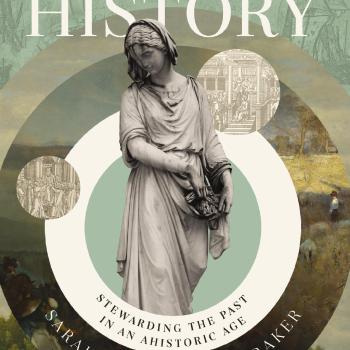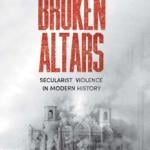My new Yale University Press book American Colonial History: Clashing Cultures and Faiths is ‘in stock’ this week at Amazon, and officially releases on April 12. My aim in this book is to tell a readable story of early America, including the meetings and conflicts of Africans, Europeans, and Native Americans. It is based on extensive reading of the most-up-to-date scholarly histories in this field, but is presented in a narrative style that should appeal to general readers and students alike. Unlike many sprawling overviews of American history, this book is tightly focused, with special attention to the themes of religion and conflict in colonial America.
Here’s an excerpt from the introduction:
“The story of America’s colonial history is one of clashing and mixing people, meeting under unexpected circumstances in places from Boston to San Francisco to Havana, Cuba. Those already in America, the Indians, found the new arrivals an unwelcome but unavoidable contender for power and trade. Africans and Europeans also brought disease and dislocation to Native American people in ways that no group fully understood. Africans, who composed by far the largest of the groups who immigrated to the Americas in the colonial era, typically came involuntarily as slaves. They found themselves living, working, and dying on new European farms and plantations, but a fraction of Africans found avenues for advancement, prosperity, and freedom. Europeans came for business opportunities, for the chance to own land, and many of them came inspired by religious convictions and the prospect of practicing their vision of full biblical faith in peace, or at least peace for those who accepted that religious vision.
Two major themes organize American Colonial History: religion and conflict. The conditions that brought these disparate peoples together almost guaranteed cultural clashes. All of the groups–Indians, Africans, and Europeans–had deep traditions of often-brutal violence among and between their own neighbors before 1492. They extended those traditions of conflict in the destabilized New World. (The “New World” was every bit as new for the Indians as it was for Europeans and Africans, even though they did not cross an ocean to get there.)
Many Europeans, Native Americans, and Africans engaged in war, torture, and enslavement, before and after the arrival of the New World, practices that most observers today would regard as inhumane and intolerable. Though some of the details of that behavior may be disturbing, this book tries neither to avoid the violence of the cultural clashes, nor to make excuses for the actions of any group. Europeans do carry a disproportionate share of the blame for the violence and dislocation: they initiated colonization, they financed and executed much of slavery’s development in the Atlantic world, they unintentionally introduced the most virulent diseases that ravaged the New World, and they possessed disproportionate power and resources for war-making.
Many in early America interpreted their interactions with their rivals, including violence and enslavement, through the lens of religion and spiritual beliefs. Although individuals varied as to the depth of their religious commitments, all peoples of Native America, Europe, and Africa brought spiritual practices and convictions with them into the colonial arena. Religion in colonial America could inspire everything from exploration to genocidal conquest, idyllic communes to generations of spite, and the dehumanization of entire peoples to advocacy for human rights.
For people in colonial America, religion was not only the path of salvation in the next life, it was a primary way of making sense of what was happening to them in the present life. It inspired groups like the Puritans to come to the New World; it drove the Spanish and French to commission evangelists among Native Americans; it offered Native Americans and Africans a measure of power in a world spinning out of control. The Europeans, most of them at least nominally Christian, sent missionaries to the front lines of empire. Some must have encouraged missions cynically, out of a desire to bolster imperial authority. Others did so out of a conviction that in Jesus, the people of the New World would find true spiritual succor into eternity. But perhaps the most common way religion functioned was to explain–explain the uncertain and often violent environment in which Americans found themselves between Columbus’s voyages and the end of the Seven Years’ War.
My hope is that readers of American Colonial History will come away with a distinct sense of how pervasive religion was in colonial America, and of the varied functions that religion served in the era, functions that were variously inspiring and appalling. The first two centuries of the American colonial story were indeed “barbarous years,” as historian Bernard Bailyn has put it, although colonial Americans before 1689 (England’s Glorious Revolution) hardly had an exclusive title to conflict and grotesque violence. Much of the story of colonial America, then, is bleak. Not that heroism was absent, but the same figures who sacrificed much to seek opportunity, or to live according the dictates of their conscience, could also brutally deny opportunity and the rights of conscience to others. Growing institutional and cultural stability did mark the period from 1689 to 1763, but patterns of conflict–often with religious roots–persisted both in settled eastern areas and in the expanding colonial west.
The greatest military clash of the colonial era, the Seven Years’ War, encapsulated many of themes of this book: violence rooted in imperial and economic rivalry was explained in religious terms (Catholic versus Protestant power), and intra-European clashes left Native Americans to make difficult decisions about alliances and the elusive possibilities of neutrality. The decisive political outcome of the Seven Years’ War–the expulsion of the French from eastern North America–stabilized the British colonies in the short term. But it left a vacuum in which yet more conflict, this time between British colonists and London-based authorities, would erupt into war and revolution in 1775.”
[Friends, you can sign up here for my Thomas S. Kidd author newsletter. Each newsletter will update you on what’s happening in my writing and offer thoughts on the best practices for productivity. It will contain unique material available only to subscribers, and each will help you keep up with my blog posts, books, and other items from around the web. Your e-mail information will never be shared. Thanks!]












